Dietary supplements are something you obviously take because you want to improve your health. And when you look at the list of ingredients in this supplement, you probably assume that all those chemicals on the product label are there for a reason and that they are necessary or beneficial to the composition of the supplement, as well as your health for some reason.
You don’t think that this dietary supplement also contains inactive ingredients that are added there simply for aesthetic, marketing, or manufacturing purposes, such as bulking agents, synthetic colorants, artificial sweeteners, etc.? Or do you?
There’s nothing inherently wrong with these inactive ingredients (and at least one of them is always there), but the more additives the supplement contains, the greater the chance that you’ll find there something you don’t want there to be because some of these inactive ingredients can actually do you harm in the long run instead of good.
This story aims to put the supplement industry under the microscope. To expose unfair practices, falling quality, and unacceptably poor standards. Since supplements are something most people consume daily, there simply has to be transparency about what exactly the things you put in your mouth contain. Vitamins and supplements should improve our health, not damage it. Right?
In this story, we’ll write about the inactive ingredients in dietary supplements that you should better avoid (like artificial sweeteners such as aspartame, acesulfame, cyclamates, etc.), the potential health risks of these substances, and a bit about the active ingredients. Most importantly, we will also write about why it is particularly important to currently prefer supplements produced in the EU, especially those made in Estonia. Be patient, this article is quite long, but it’s important that you’ll read it until the end because there are a lot of important things you should know about.
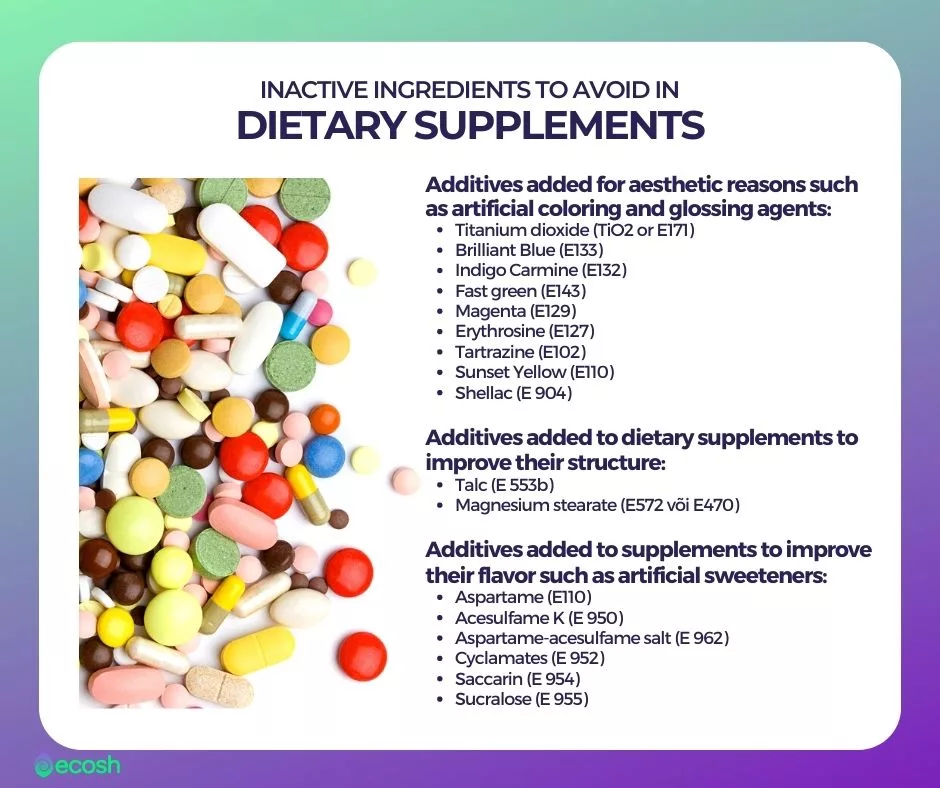
Non-active ingredients in dietary supplements to be wary of
Inactive ingredients in supplements are not the reason you buy certain supplements but are present in every dietary supplement to a greater or lesser extent. These include additives added for aesthetic reasons (such as coloring and glossing agents); substances added to improve texture (anticaking agents and bulking agents); and substances added to improve the taste of the supplement (such as synthetic sweeteners).
Below we bring you the list of these substances that you should better avoid, and choose a different supplement when you see them on the product label. This is particularly true for those who like to order their supplements from outside Estonia or the EU.
1. Additives added for aesthetic reasons such as artificial coloring agents Titanium dioxide (TiO2 or E171), Brilliant Blue (E133), Indigo Carmine (E132), Fast green (E143), Magenta (E129), Erythrosine (E127), Tartrazine (E102), Sunset Yellow (E110) and glossing agents such as Shellac (E 904)
Why are artificial coloring agents used?
Artificial coloring agents, or synthetic colorants, are used in foods and dietary supplements to bring out natural colors, to add color to colorless and ‘fun’ foods, and to help identify flavors (for example, purple color for grape flavor or yellow for lemon flavor).
Artificial colors are produced by chemical reactions and are widely used in the food and pharmaceutical industries. Synthetic colors are preferred precisely because they are quite strong and easy to play with. Natural colors, on the other hand, are sensitive to heat and therefore need to undergo heat treatment before natural pigments can be used.
In recent decades, food colors have been used in countless products consumed by people of all ages, but unfortunately, the biggest consumers of artificial colors are children. The consumption of synthetic colorants has increased by 500% over the last 50 years. Throughout this time, companies have found most of them to be harmful to health, yet they continue to include them in their products. Synthetic colorants are not only found in countless food products but also in sports drinks and dietary supplements (17).
It is important to note that some synthetic colorants are banned in many countries, and for good reason, but strangely, in the US, the FDA has approved the use of several artificial coloring agents in food and supplements that are toxic (17).
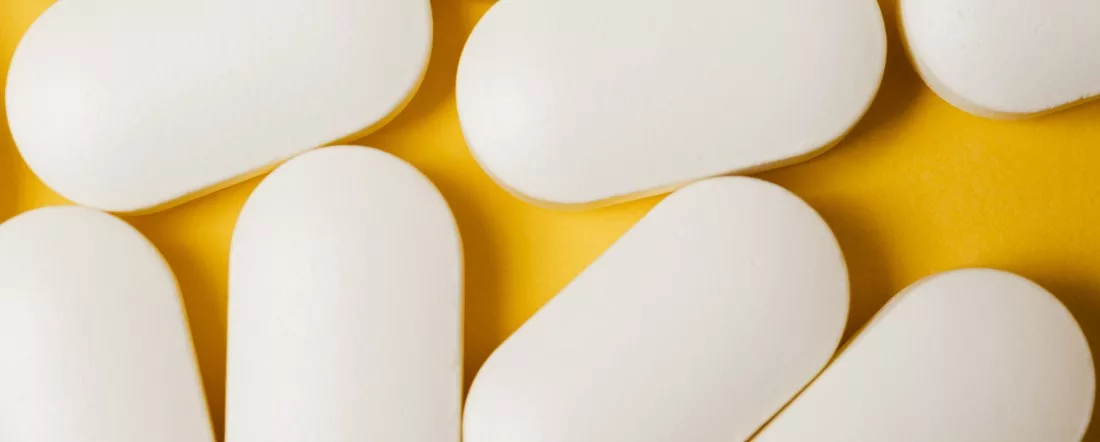
1.1 Titanium dioxide (TiO2 or E171).
Why and where is Titanium dioxide used?
Titanium dioxide, also known as titanium oxide, is a compound commonly used as a coloring agent that gives a tablet a beautiful clean bright white appearance. Titanium dioxide is also used as a colorant agent in the food industry, the paper industry, plastic products, inks, and in oil and acrylic paints.
However, in 2021, the European Food Safety Authority (EFSA) announced that Titanium dioxide can no longer be considered safe for humans due to its genotoxicity (genotoxicity is the ability of a chemical substance to damage DNA) (3).
Unfortunately, however, many supplement manufacturers, for example in the USA, believe otherwise. They are not bound by any regulation and Titanium dioxide is a necessary ingredient for them – it is a cheap and useful tool that gives the product the appearance of purity.
Health risks of Titanium dioxide
Acute health effects
Immediately after exposure to titanium dioxide, the following acute (short-term) health effects may occur:
- Exposure may irritate the eyes, nose, and throat (5).
Chronic health effects
The following chronic (long-term) health effects may occur until some time after exposure to Titanium dioxide and may last for up to several months or years:
- Cancer risk. Titanium dioxide may be carcinogenic to humans as it has been shown to cause lung cancer in animals. Many scientists also believe that there is no safe level of exposure to this carcinogen (5).
- Risk to reproduction. According to currently available information, the effects of Titanium dioxide on reproduction have not been tested, but it is thought that such carcinogens may also have the potential to cause harm to the reproductive system in humans (5).
Is titanium dioxide banned in the USA?
The United States Food and Drug Administration (FDA) recently informed the Titanium Dioxide Manufacturers Association (TDMA) that the FDA continues to consider the use of Titanium dioxide (TiO2) safe. So, the FDA classifies Titanium dioxide as generally recognized as safe (GRAS). The Agency regulates food additives such as Titanium dioxide through the Food, Drug, and Cosmetic Act of 1938 (2).
This is particularly important to know for those who like to buy their supplements from US manufacturers, don’t follow the country of manufacture, or are not familiar with the requirements for food supplements in the country of manufacture.
Is titanium dioxide banned in Europe?
The European Commission banned the use of titanium dioxide (TiO2) as a food additive in 2022. The EU Court of Justice later overturned a regulation that classified Titanium dioxide as a carcinogen under certain conditions (in inhalation in powder form), but this does not affect its use as a food additive, which is still banned in the EU. Titanium dioxide is only authorized for use in medicinal products (4, 26).
Alternative to titanium dioxide in the food industry
Current alternative sources of Titanium dioxide in the food and supplement industry are modified starch, calcium carbonate, and calcium phosphate. Although not as effective as titanium dioxide as a whitening agent, they are effective options for applications such as white coatings in confectionery and as opacifiers in sauces and soups (6).
Unfortunately, despite not being considered ‘safe’, titanium dioxide, or E171, is still present in many foods and supplements in the USA. But, this substance is far from being the only possibly harmful additive added to dietary supplements for aesthetic reasons.
Is Ecosh using titanium dioxide in its dietary supplements?
Ecosh is not using Titanium dioxide in its supplements.

1.2. Other possibly toxic synthetic colorants in food and dietary supplements
- Blue No. 1 (E133) Brilliant Blue:
- In the USA: FDA-approved and permitted.
- In the European Union: partially permitted in the EU, meaning E133 is permitted to use only in certain foods, such as in dried fruits, and canned fruits, but is banned to use in dietary supplements.
- Blue No. 2 (E132). Indigo Carmine:
- In the USA: FDA-approved and permitted.
- In the European Union: allowed in some countries, but banned in countries such as Norway, Finland, and France, probably because they have been linked E132 to brain cancer.
- Green No. 3 (E143). Fast Green
- In the USA: It is listed by the FDA as a safe additive and therefore permitted.
- In the European Union: banned.
- Red No. 40 (E129). Allura Red:
- In the USA: this dye has been approved by the US Food and Drug Administration (FDA).
- In the European Union: it is currently approved by the European Food Safety Authority (EFSA) also but is banned in Switzerland and the UK due to its potential adverse health effects.
- Red No. 3 (E127). Erythrosine:
- In the USA: allowed in the USA.
- In the European Union: allowed to use only in one specific food category such as canned fruits and vegetables, but not in dietary supplements.
- Yellow No 5 (E102). Tartrazine:
- In the USA: allowed.
- In the European Union: allowed to use only in a few specific foods such as processed fish and fish products, flavored wine, canned fruit and vegetables, processed cheese products, etc., but banned in dietary supplements.
- Yellow No 6 (E110). Sunset Yellow:
- In the USA: permitted.
- In the European Union: permitted in many foods, including dietary supplements. Banned in Norway and Finland only (11, 17, 21, 26).
Why are there artificial colors possible health risks?
Some of these colors are actually derived from toxic coal tar. Coal tar, in turn, is a mixture of many chemicals derived from petroleum. However, petroleum is recognized as carcinogenic to humans. So the main concern with some dyes (whether derived from coal tar or synthetically) is their potential carcinogenicity.
Coal tar dyes are usually formed as a by-product of hydrocarbon solvents. They are used to dilute bituminous coal, a form of coal often used in steel production. When coal is diluted with these hydrocarbon solvents, a variety of colors are formed that you may recognize in many of your favorite products. These colors may also be contaminated with small amounts of heavy metals and may even be combined with aluminum substrate.
However, aluminum compounds and many heavy metals are toxic to the brain. Coal tar is used for applications such as roofing, exterior paints, and heating, so it is obvious that it should not be ingested.
Studies have found that yellow No 5 causes genetic damage. Yellow No. 6 has been linked to allergies, colds, and tumors in animals. Artificial colorants have also been found to cause irritability, hyperactivity, and aggression in children, and are linked to autism (17, 18, 19, 20).
Is Ecosh using artificial colors in its dietary supplements?
Ecosh does not use any coloring agents in its food supplements – neither natural nor synthetic.

1.3. Shellac (E 904)
Why and where is shellac used?
Another substance to be aware of is shellac – the same substance that is applied to nail varnish as a top coat. Shellac is a resin secreted by an insect (the female varnish beetle) on tree trunks in the forests of India and Thailand. The resin is scraped off the tree trunk and, as shellac is a natural glue and transparent coating, it is mainly used in food coatings, cosmetics, and varnishes. Shellac is mostly used in the coatings of chewing gums, fruits, confectionery, as well as coffee beans, and is often referred to as ‘confectioner’s glaze’ or ‘confectioner’s resin’.
Shellac is also widely used to coat capsules and tablets in the pharmaceutical industry. In the past, it was used in dentistry to make dentures and other products.
Chemically, shellac consists mainly of lauric acid and other natural waxes. This gives dietary supplements a glossy, glazed appearance, which is why supplement marketing teams love shellac. It’s much easier to sell a glossy, attractive tablet than a dull, boring one.
Health risks of shellac
The health risks listed below relate more to the risks of exposure to shellac vapors, for example in the workplace, where it can enter the body through the skin, inhalation, ingestion, or the eyes.
Possible consequences of overexposure to shellac may be:
- Health risk due to eye contact:
- May cause eye irritation.
- Health risks due to skin contact:
- Prolonged or frequent skin exposure may cause irritation.
- Health risk due to inhalation:
- High vapor concentration may irritate the eyes, nose, respiratory tract, and lungs. Inhalation of shellac vapor may also affect the brain or nervous system, causing dizziness, headache, or nausea, so avoid inhalation of shellac vapors or mists.
- Health risk if swallowed:
- Shellac may enter the lungs and cause damage.
- Health risk from prolonged exposure (e.g. in the workplace):
- Prolonged and frequent exposure to shellac has been linked with permanent brain and nervous system damage (9).
Is shellac still considered safe for intranasal administration?
Although few people are allergic to shellac, its usage in glaze food and pharmaceutical products is currently considered safe for oral administration (7).
Is shellac permitted in the US and approved by the FDA?
In the United States, shellac is on the FDA list of resin and polymer coating materials that “can be safely used on food contact surfaces intended for use in the manufacture, preparation, packaging, processing, packing, transport or storage of food.” (8).
Is shellac also allowed in the European Union?
Shellac (E904) is a food additive approved under Annex IV to EC Directive 95/2/EC and categorized as a ‘Glaser substance’ (11).
An interesting and yet controversial fact
In 2008, the European Commission adopted a regulation which, together with talc (E 553b) and carnauba wax (E 903), allowed the use of shellac only on the surface of unpeeled colored boiled eggs as they can serve a decorative purpose by giving a glossy effect. The Regulation also mentioned that, in addition, shellac (E 904) may contribute to better preservation of the product when used on the surface of all unpeeled boiled eggs, and that these bulking agents will unlikely migrate into the edible part of the eggs because of their high molecular weight and insolubility.
The Regulation stated that the use of these substances as food additives unlikely affects human health as these waxes remain on the eggshell. Therefore, the use of talc (E 553b) and carnauba wax (E 903) was authorized for unpeeled colored boiled eggs and the use of shellac wax (E 904) was authorized for all unpeeled eggs (10 ).
So, without any hesitation, we all continue to eat this ‘safe’ glaze substance, that is meant to not migrate on the edible part of the food.
Is Ecosh using shellac in its food supplements?
No, and never has been.
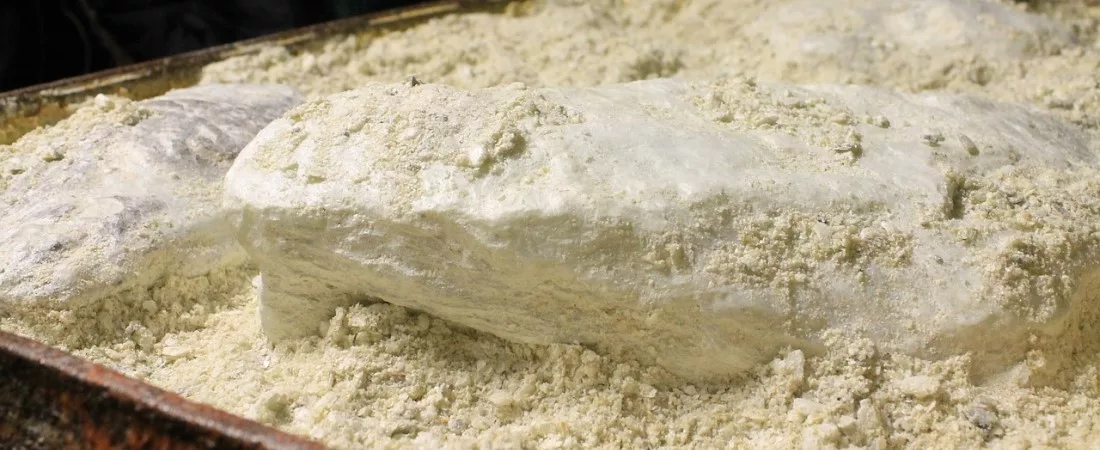
2. Additives added to dietary supplements to improve their structure, such as anticaking agents talc (E 553b) and magnesium stearate (E572 or E470)
Fillers and anticaking agents are another common category of inactive ingredients. They do exactly what their name implies – they bulk up a supplement, i.e. they add volume to make it look bigger and therefore, in our subconscious, more effective.
There is nothing inherently dangerous about fillers or anticaking agents. However, the lack of regulation in some parts of the world means that nobody controls what is used as a filler. So let’s list some of the substances that are often added to dietary supplements as bulking agents or to improve the structure, but for which there are healthier alternatives.
2.1. Talc (magnesium silicate or E 553b)
Why is talc used in food supplements?
One of the most popular examples of a filler is talc, which also helps to hold tablets together. In food products and supplements, talc is used as an anticaking agent. Also, it prevents the components of dietary supplements from sticking to tablet-producing machines.
In foods, talc is mineral inert. So it passes through the body undigested and is therefore used as a carrier for food colors and as a release agent in sweet products, bakery products, rice, dried food powders, condiments, cheese, sausages, and table salt (1, 12).
It is often hidden behind the scientific name, magnesium silicate, but it is still talc – and the less talc the better (1, 12).
Why talc can be a health risk
Because of its GRAS (Generally Recognized As Safe) status, talc used in dietary supplements, for example in America, does not have to undergo purity or contamination testing because there are no regulations prohibiting asbestos in talc (12).
However, because asbestos and talc are minerals extracted from the earth, certain types of asbestos occur in the natural environment together with talc. This means that talc excavated for commercial use may be contaminated with asbestos.
Although the U.S. Food and Drug Administration (FDA) considers the use of asbestos-contaminated talc in any product unacceptable, it can only act if it is scientifically proven that the product is harmful to health. And while there would seem to be a basis for doing so in the case of talc, there is still insufficient research to ban its use in the food industry.
For example
In a presentation at the European Respiratory Society’s (ERS) International Congress, Dr. Jos Rooijackers, a pulmonologist at the Netherlands Centre of Expertise on Occupational Diseases (NECORD), said that awareness of the health risks of inhaling talc is insufficient and needs to be addressed urgently.
Dr. Rooijackers and colleagues studied workers in a chocolate factory where talc was regularly used in the production process. One of the factory workers had already been diagnosed with silicosis (a lung disease in which inhalation of talc causes pneumonia). Subsequent investigation revealed the same health problem also in another worker. The damage progresses with continuous exposure and can lead to pulmonary fibrosis and respiratory failure.
“Even though silicosis is a known health risk in talc in industries, the company did not recognize this risk as talc is generally considered safe” said Dr. Rooijackers (13).
Talc powder has also been studied concerning cancer. Most of the concern about possible links between talc and cancer has focused on the following topics:
- Whether people with long-term exposure to talc particles at work have a higher risk of lung cancer.
- Does regular use of talc in the genital area increase the risk of ovarian cancer (14)?
In addition, some studies and court cases link asbestos-contaminated talc powder to mesothelioma, a type of cancer that most commonly affects the lining of the lungs, but can also develop in the lining of the abdomen or heart. Asbestos exposure has been associated with all three of these cancers.
People can inhale or swallow talc powder contaminated with asbestos fibers. This can cause inflammation and scarring and lead to mesothelioma. According to the International Agency for Research on Cancer (IARC), asbestos-contaminated talc is “carcinogenic to humans”. However, the agency, which is a sub-unit of the World Health Organisation, also specifies that asbestos-free talc is “not classified as carcinogenic to humans” (15).
Is talc allowed in the US?
As a food additive, talc is generally recognized as safe (GRAS) by the US Food and Drug Administration (FDA) (12).
Is talc also authorized in the European Union?
In the European Union, talc, or E 553b, is on the list of authorized additives as an anticaking agent. However, the specific requirements specifically mention that it is only asbestos-free talc that is allowed (11).
Interesting fact
There have been problems with talc powder safety in the past, with Johnson & Johnson being forced to pay almost $5 billion in damages due to health concerns. They appear to have improved their performance, but people should still be cautious about suspicious talc sources (1).
Does Ecosh use tallow in its food supplements?
No, Ecosh has never used talc in the production of its supplements and will not use it in the future.
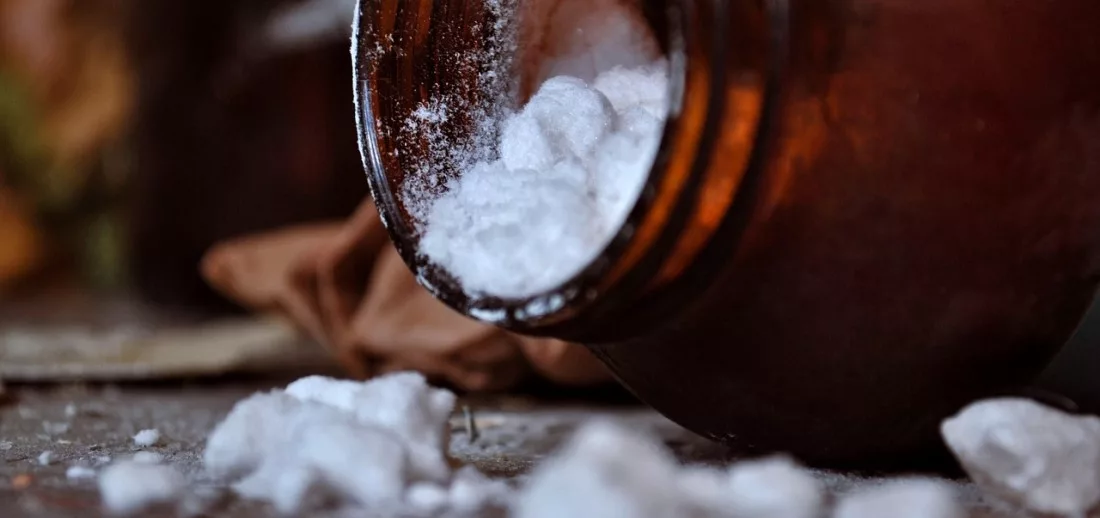
2.2 Magnesium stearate or magnesium salts of fatty acids (E572 or E470b)
One of the most common anti-caking agents is magnesium stearate. It is an industrial lubricant that prevents ingredients from sticking to production equipment when chemical powders are compressed into solid tablets. It also prevents blockages in the production line. This is why magnesium stearate is often used in the manufacture of medical tablets, capsules, and powders.
Although magnesium stearate is the most commonly used tablet lubricant, it can lead to lower tablet wettability and slower disintegration, and thus slower and even lower dissolution of the drug.
Potential health risks of magnesium stearate
Magnesium stearate is generally considered to be safe when taken orally, but in excessive doses, it may irritate the intestinal mucosa and trigger diarrhea. There are also several other raising potential concerns:
- Immune function. It has been suggested that magnesium stearate powder may weaken immune T-cell function, but studies on this effect are still in the early stages (16).
- Pesticide-related concerns. Stearate is sometimes derived from cottonseed oil, and therefore some are concerned that although magnesium stearate undergoes an intensive purification process before being used in pharmaceuticals, it may still contain dangerous pesticides and is, among other things, genetically modified (16).
- Nutrients and drug absorption. There is some concern that magnesium stearate may interfere with the absorption of nutrients by the body. In one study medications containing magnesium stearate took longer to dissolve than tablets without this substance. In other studies, the dissolution time of magnesium stearate was found to not affect the efficacy of either the drug or the supplement (16).
- Biofilm. There is also concern that magnesium stearate may cause the formation of harmful biofilms in the digestive system. Biofilms form when bacterial groups form a protective barrier. This suspicion arises from the fact that magnesium stearate is also present in soap, which, for example, also forms a thin film on bath water or bathroom walls. However, the biofilm lining the intestine is different from the bathroom wall (16).
- Allergens. Allergic reactions to magnesium stearate are rare, but if this concerns you, simply avoid the substance and talk to your doctor about the possibility of finding magnesium-stearate-free medicines (16).
Is magnesium stearate allowed in the US and what is the safe amount?
The FDA has approved magnesium stearate and permits its use as an additive in foods and dietary supplements. Also, according to the National Center for Biotechnology Information (NCBI), magnesium stearate is safe for use in small amounts. The recommended amount is less than 2500 milligrams (mg) per kilogram per day. This equates to about 170 000 mg for a 150 kg adult, which is much more than is actually contained in dietary supplements (16).
Is the use of magnesium stearate in the food industry allowed in Europe?
Also in Europe, magnesium stearate, known as magnesium salts of fatty acids or E470b, is authorized in the list of food additives as an emulsifier, stabilizer, and anticaking agent (11).
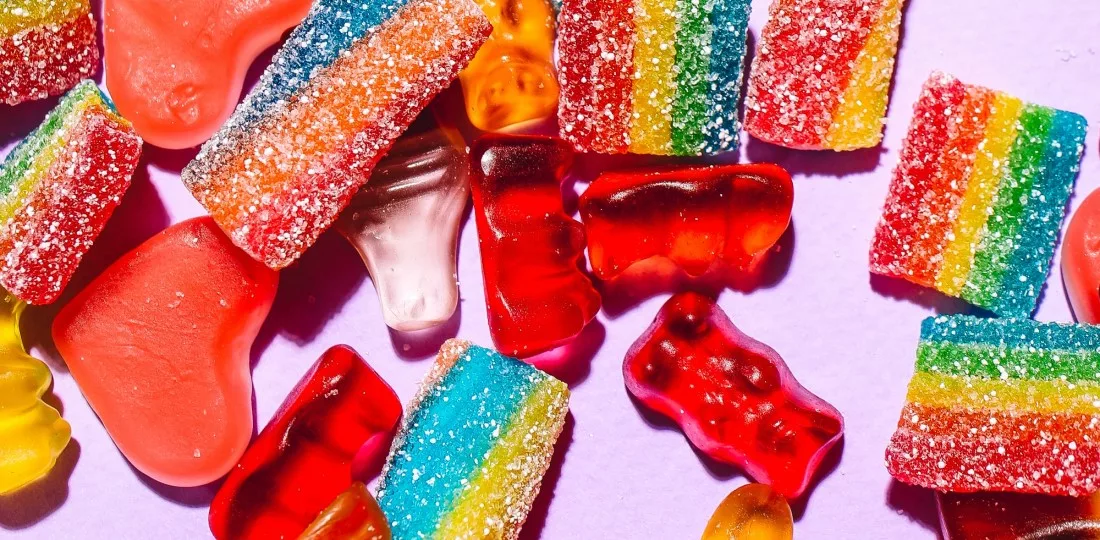
3. Additives added to supplements to improve their flavor such as artificial sweeteners aspartame (E 951), acesulfame K (E950), aspartame-acesulfame salt (E 962), cyclamates (E 952), saccharin (E 954) and sucralose (E 955)
Natural sweeteners (e.g. sucrose or sugar, fructose, honey, stevia, molasses) and artificial sweeteners (e.g. aspartame, acesulfame, aspartame-acesulfame salt, cyclamate, saccharin, mannitol, isomalt, sorbitol, xylitol, erythritol) are among the most common food ingredients and additives. These ingredients are classified as “caloric” (e.g. sucrose, sugar alcohols, and hydrogenated starch hydrolysates) or “non-caloric” (e.g. cyclamate, saccharin, aspartame, sucralose, acesulfame potassium, steviol glucoside) or, depending on their energy contribution, as “nutritive” or “non-nutritive”, respectively.
In addition, the term “natural origin” is sometimes used in the information provided to the consumer, as in the case of steviol glucoside, or “artificial origin” if the sweeteners are synthetic. Synthetic or artificial sweeteners are often used in the production of non-alcoholic beverages, confectionery, fermented foods, and sauces, as well as energy-restricted foods, dietary foods for medical purposes, or dietary supplements (29).
The history behind artificial sweeteners
Artificial sweeteners became popular during the world wars as a response to reduced sugar production due to the agricultural crisis. At that time, saccharin was a highly accepted alternative to sugar and its sweetening properties were discovered by chance by Remsen and Fahlberg in 1879 when Fahlberg noticed that his dinner sandwich became very sweet after he forgot to wash his hands after a full day in the laboratory.
In the early 1950s, the replacement of sugar with artificial sweeteners was seen as a desirable way to reduce the high-calorie content of foods, as the rapidly expanding confectionery and fast-food industries were accompanied by a rise in obesity. While the demand for diet products continued to grow, saccharin gradually lost popularity due to its bitter aftertaste, and a new, better-tasting artificial sweetener had to be found.
An important development was the appearance of cyclamate, which did not have a bitter aftertaste and could be used to sweeten non-alcoholic drinks. However, FDA banned its use in the US due to suspicions that cyclamate could cause cancer. Interestingly, cyclamate is still not banned in other countries.
After this, the invention of aspartame in 1965 proved to be a breakthrough. James M. Schlatter, the inventor of aspartame, got the compound as part of his research into anti-diarrhoeal drugs. He discovered the sweetener completely by accident after licking his finger, which was actually against workplace safety regulations. After some complications in legalizing aspartame as a food additive, large-scale production began in 1981.
When aspartame came on the market in 1981, it was marketed under the name NutraSweet and was not initially suspected of being carcinogenic. Aspartame is still one of the main artificial sweeteners in North America, Europe, and Asia (23, 25).
Some of the most common artificial sweeteners are aspartame (E 951), aspartame-acesulfame salt (E 962), cyclamates (E 952), saccharin (E 954), and sucralose (E 955).
3.1. Aspartame (E 951)
Aspartame is an intense, low-calorie artificial sweetener. The attractiveness of this white, odorless powder as a sweetener lies in the fact that it is about 200 times sweeter than sugar, whereas the calorific value of aspartame is almost zero. However, the taste of aspartame is not identical to ordinary sugar, takes longer to develop, and usually has an aftertaste.
Aspartame is the most widely used artificial sweetener in the world and is also marketed as NutraSweet, Equal, Sugar Twin, and AminoSweet.
It is found in more than 6,000 products, including Diet Cola and Pepsi and other artificially sweetened beverages; sugar-free chewing gum; sugar-free candy; low- or no-sugar sweet sauces such as ketchup; children’s medicines and vitamins; and other dietary supplements.
Aspartame is a synthetic chemical consisting of the amino acids phenylalanine and aspartic acid together with methyl ester. On ingestion, the methyl ester breaks down to methanol, which can be converted to formaldehyde (24).
In the human gastrointestinal tract, aspartame is converted to aspartic acid, phenylalanine, and methanol. The latter two are actually considered undesirable for the human body. One in 10 000 people have a condition called phenylketonuria and therefore food containing aspartame is labeled as ‘containing phenylalanine’ (25).
Potential health risks of aspartame
Although many studies, some of which are of course sponsored by the industry itself, have not reported problems associated with aspartame, decades of independent studies have linked aspartame to a wide range of health problems, including:
- cancer;
- brain tumors;
- cardiovascular problems;
- stroke, dementia, and Alzheimer’s disease;
- seizures;
- neurotoxicity, brain damage, and mood disorders;
- headaches and migraines;
- impaired kidney function;
- weight gain, increased appetite, and obesity-related problems;
- diabetes and metabolic disorders;
- intestinal dysbiosis;
- abnormalities of pregnancy such as premature birth and overweight babies;
- sperm damage;
- liver damage and glutathione depletion (24).
Is aspartame approved in the US?
The use of aspartame as a food sweetener is permitted in the USA. The brands of aspartame are Nutrasweet®, Equal®, and Sugar Twin®.
According to the FDA, the maximum daily intake of aspartame allowed in the United States is 50 mg per 1 kg body weight for both adults and children. Because aspartame is contained in a wide variety of products, both children and adults may unintentionally and unknowingly consume higher amounts than the FDA recommends. This, however, may lead to serious health problems. In the USA, foods containing aspartame must be labeled “contains phenylalanine” (23, 25, 32).
Is aspartame authorized in the European Union?
The European Food Safety Authority (EFSA) reassessed the safety of aspartame in 2013 and concluded that the permitted daily intake of 40 mg per kilogram (body weight) is sufficient to protect human health from the potential adverse effects of aspartame.
Aspartame is therefore permitted in Europe as an additive in foods such as beverages, desserts, confectionery, dairy products, chewing gums, low-energy and weight-control products, dietary supplements, and also as table-top sweeteners (22). In the EU, the labeling of foodstuffs containing aspartame must indicate its name or E-number (E 951) (22).
Does Ecosh use aspartame in dietary supplements?
No.
3.2 Acesulfame-K (E 950)
Acesulfame or acesulfame potassium (also known as Ace-K) is added to many beverages, bakery products, packaged products, and also dietary supplements to increase sweetness. However, unlike aspartame, it has been less talked about and is often overlooked by consumers.
This substance tolerates heating well but has a slightly bitter aftertaste in large quantities. Acesulfame is often used in beverages, for example, in combination with other sweeteners, as it gives a synergistic effect (when several sweeteners are used together, the same sweetness is obtained when smaller amounts are used), and the aftertaste is masked when different sweeteners are used together.
Potential health risks of acesulfame-K
Acesulfame-K has been one of the most studied artificial sweeteners (along with other most commonly consumed ones such as aspartame and sucralose) for its possible association with increased cancer risk.
In one large cohort study, artificial sweeteners (particularly aspartame and acesulfame-K), used in many food and drink brands worldwide, were associated with an increased risk of cancer.
In fact, the results of this particular study alone should be sufficient to reassess the authorization of sweeteners such as aspartame, acesulfame-K, and sucralose (27).
Is acesulfame-K authorized in the USA?
Acesulfame-K has been approved by the FDA since 1988 and it is one of the six low-calorie artificial sweeteners currently permitted for use in food in the United States. A safe daily intake (ADI) is considered to be 9 mg per kilogram (body weight) per day (32).
Is acesulfame-K authorized in the European Union?
Acesulfame-K is authorized in the EU as an additive in foods and also in supplements, except foods for infants (26 ).
Does Ecosh use acesulfame-K in dietary supplements?
No.
3.3. Aspartame-acesulfame salt (E 962)
Aspartame-acesulfame salt is a white and crystalline synthetic sweetener produced by the maceration and crystallization of a 2-1 mixture of aspartame and acesulfame potassium in an acidic solution. During the process, moisture and potassium are removed.
Aspartame-acesulfame salt is marketed under the name Twinsweet, which in fact very well describes its ‘double sweet’ property (about 350 times sweeter than sugar, while aspartame and acesulfame are each about 200 times sweeter than sugar).
Health risks of aspartame-acesulfame salt
This is a very simple and self-explanatory story. Namely, when aspartame-acesulfame salt dissolves somewhere (already in saliva, but certainly also in the stomach), the two synthetic sweeteners it contains separate from each other and continue to act in the body in exactly the same way as if they had been consumed separately. Thus, by ingesting aspartame-acesulfame salt, you get two in one – aspartame and also acesulfame-K, and we have already written about the potential health risks of these two (33).
In addition, although not all studies support the view that combining aspartame and acesulfame-K adds anything toxicologically, adverse effects such as dizziness, headache, and nausea have been reported with aspartame-acesulfame salt (33).
Is aspartame-acesulfame salt allowed in the USA?
Yes, and it is subject to the same rules as acesulfame-K and aspartame separately. This means that it can be used in exactly the same products as acesulfame-K and aspartame (32).
Is aspartame-acesulfame salt legal in the European Union?
Aspartame-Acesulfame salt is legal in the EU for use as a sweetener in several foodstuffs, including dietary supplements (26).
Does Ecosh use aspartame-acesulfame salt in food supplements?
Of course not.
3.4. Cyclamate (E 952)
This synthetic sweetener is around 30 times sweeter than sugar (sucrose). Cyclamate is used as a sweetener in bakery products, confectionery, desserts, soft drinks, preserves, dietary supplements, and salad dressings. It is often combined with saccharin to achieve a synergistic sweetening effect. Cyclamates were formerly used in pharmaceuticals to mask the bitter aftertaste.
Potential health risks of cyclamate
Numerous studies have shown that in some humans, cyclamate can cause the formation of a substance that has been shown to cause testicular damage in animal studies at significant doses (28). In addition, it is also suspected that this substance may also play a possible role in increasing cancer risk (23).
Is cyclamate allowed in the USA?
Usually, what is allowed in the USA is banned in the European Union, but strangely in this case the tables have turned and cyclamate has been banned in the USA since 1969. Even Coca-Cola uses cyclamate to sweeten one of its most famous drinks, Coca-Cola Zero, in many European countries, whereas the same product does not contain this substance in the USA (32).
Is cyclamate allowed in the EU?
In the EU, cyclamate is allowed in a wide range of foodstuffs and also in dietary supplements (26).
Does Ecosh use cyclamate in its products?
No.
3.5. Saccharin (E 954)
Saccharin has been in use for almost 150 years. In spite of some disagreements in the 1980s, saccharin is now an approved calorie-free artificial sweetener that is about 200 to 700 times sweeter than ordinary sugar.
Saccharin is one of the cheapest low-calorie sweeteners and is therefore extremely popular and widespread. Saccharin is used as a sweetener in low-calorie processed foods such as fruit juices, candies, jams, jellies, biscuits, and also in dietary supplements.
Potential health risks of saccharin
One drawback of using saccharin is that some studies have shown that consuming high amounts of saccharin can negatively affect the balance of bacteria in the gut. Changes in the gut microbiota can lead to type 2 diabetes, obesity, and, in rare cases, cancer (30).
Is saccharin allowed in the US?
Yes (32).
Is saccharin allowed in the European Union?
In the EU, saccharin is allowed in a wide range of foods and also in dietary supplements (26).
Does Ecosh use saccharin in its products?
No.
3.6. Sucralose (E 955)
Sucralose is marketed under the name Splenda. Although it is an artificial sweetener, the difference between Splenda and other sweeteners such as aspartame and saccharin is that sucralose is actually made from real sugar. This also gives sucralose a taste that is generally preferable to other artificial sweeteners.
Sucralose has been chemically modified to be about 600 times sweeter than regular sugar and is almost completely calorie-free. It also leaves no aftertaste in the mouth, which is why it is used in foods such as yogurt, sweets, ice cream, lemonade, soft drinks, and dietary supplements all over the world.
In addition to changing the taste, sucralose is also modified so that instead of being absorbed and later used for energy, most of it simply passes through your body. To make sucralose almost calorie-free, some naturally occurring parts of the sugar molecule, called hydroxyl, are exchanged for chlorine (31).
Potential health risks of sucralose
According to some studies, sucralose can reduce the number of good bacteria in the gut by as much as half, thereby altering the gut microbiome. Studies in animals show that sucralose can also increase inflammation in the body. Over time, however, inflammation can contribute to problems such as obesity and diabetes (31).
Is sucralose legal in the US?
Yes (32).
Is sucralose allowed in the European Union?
In the European Union, sucralose is also permitted in a variety of foods and dietary supplements (26).
Does Ecosh use sucralose in its products?
No.
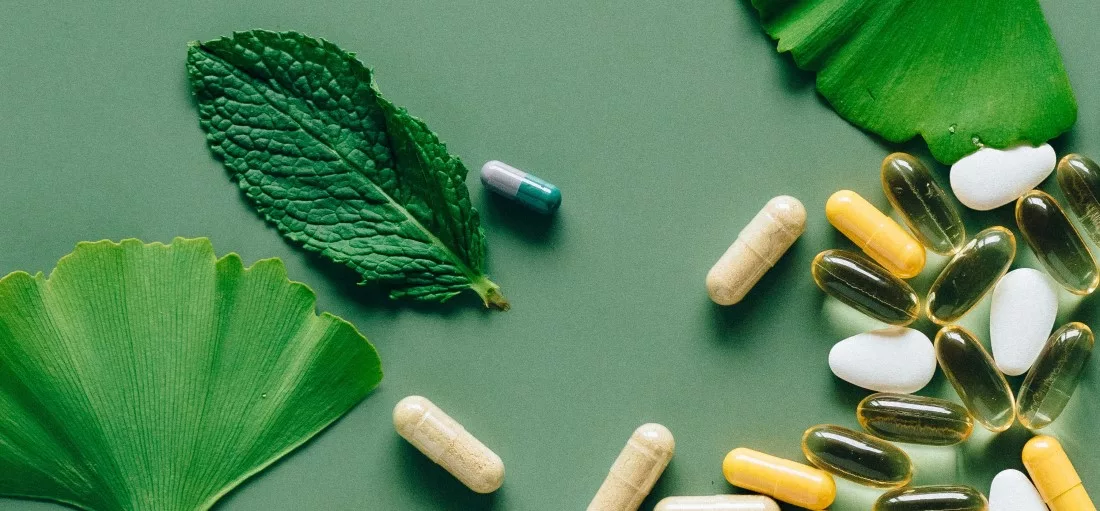
Know your active ingredients – quality of the active ingredients, forms that can be absorbed by the body, quantities, ethical sourcing and why should you choose dietary supplements produced in Estonia
Anything that is not an inactive ingredient in a dietary supplement listed above is an active ingredient. These are the substances in a supplement that are supposed to have an effect. However, not all active ingredients are created equal, and if you are looking for a good quality supplement, it is important to make sure you know what the active ingredients are and whether they are actually beneficial.
Quality of the raw materials and the forms that can be absorbed by the body
Ensuring the quality and efficacy of the ingredients in any supplement should be your top priority precisely because otherwise you’re simply wasting money. Therefore, monitor the specific form of the nutrient in your supplement. The form of the ingredient, or compound, determines how easily it enters your bloodstream (this is called bioavailability) and can take effect. Knowing the compounds in a supplement is as important as knowing the basic nutrients.
For example, everyone knows how important is vitamin B12. The most common form of B12 used in dietary supplements is a synthetic compound called cyanocobalamin. However, this form is very difficult for your body to absorb. In addition, in order to use it, your body also needs to convert cyanocobalamin into the active form of the vitamin, methylcobalamin. This requires a lot of work and is an inefficient process. This means that after all these bodily processes, only a small proportion of the B12 in the supplement may actually work.
But, a good quality supplement may already contain methylcobalamin itself. In this form, B12 is more easily absorbed and does not need to be converted by the body before use. Yes, it’s not as good for the manufacturer’s profit margin to produce a form that is readily absorbed or bioavailable, but it’s many times better for the supplement consumer.
If you consume several vitamins at the same time and they are not bioactive, the amount of work your body has to do to access these many different nutrients can be huge.
In Ecosh selection, there are several bioactive supplements such as:
- Bioactive Magnesium Glycinate
- Bioactive Vitamin B for the Heart
- Bioactive Vitamin B12
- Bioactive B Complex
- Bioactive Vitamin C
- Bioactive Zinc Diglycinate
- Bioactive Iron Diglucinate
In addition to bioactive forms, liposomal vitamins are also considered to be particularly well-absorbed and effective. The following Ecosh liposomal vitamins and minerals are available:
- Liposomal vitamin C
- Liposomal magnesium
- Liposomal vitamin C
- Liposomal vitamin D3 for vegans (made from moss)
Quantity
There are standards for how much of an active ingredient a dietary supplement must contain before it can be listed as an ingredient. This is undoubtedly a good thing, because for a supplement to have an effect, it must contain the right and sufficient amount of the active ingredient.
Unfortunately, however, many of the standards are hopelessly out of date, as they are based on nutrient reference values (NRVs) developed in the twentieth century. But our world is not the same place today.
When it comes to doses, two things could be a problem here. The first is a dietary supplement that does not contain a sufficient amount of nutrients. And even if there is actually enough to add a health claim on the label, it may not be enough for you to feel the effects of the active ingredient.
Another potential problem is a supplement that contains too much nutrients. This is especially important for fat-soluble vitamins, such as vitamin A, which build up in your cells over time. So it is always important to check the amounts of each nutrient and the safe upper limit set by local regulators (1).

Ethical sourcing
Where do nutrients come from? When it comes to food, we know that iron comes from red meat or green leaves, and vitamin C from citrus fruits, but at the industrial level, it is different. Supply chains are more hidden and it’s a bit harder to know exactly where your vitamins come from.
For example, most supplement companies don’t process millions of eggs to collect vitamin D3 (the more bioavailable form of vitamin D). Instead, most supplements get vitamin D3 from wax collected from sheep’s wool. After collection, the wax is treated with various detergents and solvents until it is in a suitable state for use in dietary supplements.
Fish oil extracted from the liver is one of the most common forms of omega 3, but almost all of it comes from Peruvian anchovies – the most overfished fish in the world. Once the oil is collected, it is sent to China for extraction and distillation and then sent back around the world. The long process means that by the time the oil reaches the shelf, it can often be rancid (1).
However, neither of these has to be this way. You can actually get vitamin D3 from sustainable mosses that grow naturally on the sides of trees and rocks. Vitamin D3 from mosses is contained in Ecosh liposomal vegan vitamin D3. And fish oil doesn’t have to be made in China or come from anchovies. For example, in Ecosh omega-3 fatty acid complex OOMEX, the fish oil is made in France, which is more stable than other omega-3 oils on the market and made from fish oil from anchovies, mackerel, and sardines.
Sustainability
Given the size of the dietary supplement industry and the global nature of the supply chain, sustainability should not be controversial. But it’s rarer than you think. Exploitation of natural resources, unwarranted waste, and reliance on single-use plastics are the norm.
We don’t think it’s all right. We believe that companies have a duty to their customers and the planet to do everything they can to reduce their carbon footprint and their impact on the planet.
Big corporations pumping out low-quality, cheap diet pills don’t think so. For them, it’s all about profit, and unfortunately, that often means sacrificing sustainability. It is time to demand more.
It’s a grim picture and the supplements industry is not in a good state. But there is better. There are high-quality supplements that use ingredients from ethical sources and use them in effective doses. You just have to do your homework and make sure you know what you are buying and what you are ingesting. This is where you shouldn’t compromise.
So, raise your standards. Ask more questions. Find out exactly what’s in the bottle. And if there’s something you’d rather not eat, don’t eat it (1)!
What you should know when buying supplements made in the USA
The U.S. Food and Drug Administration (FDA) does not regulate dietary supplements in America. Instead, dietary supplements have been covered by the Dietary Supplement and Health Education Act (DSHEA) since 1994.
DSHEA defines a dietary supplement as a product intended to complement the diet that contains one or more dietary ingredients, such as:
- A vitamin, mineral, herb, or other plant substance,
- amino acids,
- concentrate, metabolite, ingredient, or extract.
A “novel food ingredient” is defined as an ingredient that meets the definition above, but was not sold as a dietary supplement in the United States before October 15, 1994.
Under DSHEA, once a dietary supplement has been placed on the market, FDA must demonstrate that it is “unsafe” before it may restrict its use or remove it from the market. In other words, this simply means that, unlike drugs, manufacturers of dietary supplements in the USA do not have to ensure that the product is safe before marketing it.
The FDA will only consider assessing safety after adverse reactions or harm have been reported through the FDA’s formal adverse reaction reporting system (12).
Why is there more control over dietary supplements in the EU than in the US?
As in many other European countries such as Austria, Bulgaria, Denmark, Finland, France, Germany, Greece, Iceland, etc., also citizens in Estonia have the right to free and universal health care. In the United States of America, citizens have to pay for their health care. Since in most European countries the government pays for its citizens’ health care, it is only logical that the European Union bans all substances that may increase the risk of disease.
In the United States, on the other hand, health care is considered a business. If you have the money, you get treatment – if you don’t, you’re out of luck. So the FDA is not as quick to ban toxins that are banned for human consumption in various other countries with free medical healthcare (21).
It should also be noted that in North America, for example, the supplement industry is worth an estimated $50 billion a year. And yet not all manufacturers or sellers of dietary supplements are required to register. So there is in fact no regulation (1).
So why is it that food supplements produced in Estonia can be the healthiest?
Another reason for trusting supplements produced in the European Union, but especially in Estonia, is very simple. Estonia is one of the smallest countries not only in Europe but in the world. This of course also means fewer manufacturers of dietary supplements.
The fewer the number of producers, the easier it is for the Food and Agriculture Board to keep an eye on their activities and also to carry out continuous checks.
Also, in such a small country you cannot make bad products, because the word gets around and in no time, everyone knows!
NOTE: In case of intolerance to any of the ingredients, do not use the products described in this story. The information provided here is for informational purposes only and should not be considered as health care or medical diagnosis and treatment. This information should not be taken as a guarantee of results to be achieved. The information provided is also not intended to be a substitute for the advice of your physician or other health care professionals.
Do not use the information here to diagnose or treat a health problem. You should consult a healthcare professional before changing or stopping treatment for any health problem, treatment, or medication, even if you suspect that you may have a health problem. Do not use supplements as a substitute for a varied diet. It is important to eat a varied and balanced diet, to lead a healthy lifestyle, and to listen to your gut!
Author: Maria-Helena Loik
Images: Pexels.com, Pixabay.com, Shutterstock.com
Sources:
- What’s going on with the supplement industry? (yourheights.com)
- FDA Reaffirms Safety of Titanium Dioxide for Use in Foods | PackagingLaw.com
- Titanium dioxide: E171 no longer considered safe | EFSA (europa.eu)
- Titanium dioxide still banned in Europe (ingredientsnetwork.com)
- 1861.pdf (nj.gov)
- ADM presents titanium dioxide alternative (foodingredientsfirst.com)
- Shellac used to boost appearence (dmshellac.com)
- Food & Agriculture – Shellac, Waxes, Natural Gums, Resins, Menthol Crystals & Zein (afsuter.com)
- file://O:\Program%20Files\ProductVision%204.0\REPORTS\~PV38879. (ucps.k12.nc.us)
- Commission Regulation (EU) No 675/2012 The use of Shellac (E 904) on unpeeled boiled eggsText with EEA relevance (europa.eu)
- Toidus lubatud lisaainete loetelu –Riigi Teataja
- Do Your Talc-Based Dietary Supplements Contain Asbestos?
- Talc use in food processing a health hazard, say researchers
- Talcum Powder and Cancer | American Cancer Society
- Talcum Powder | Uses, Talc, Deadly Cancers & Asbestos Link (drugwatch.com)
- Magnesium Stearate: What It Is, Its Uses, and More (webmd.com)
- Toxic dyes in vitamins & supplements – Protea Nutrition
- Developmental neurotoxicity of industrial chemicals – PubMed (nih.gov)
- Food Color and Autism: A Meta-Analysis – PubMed (nih.gov)
- Food additives and hyperactive behaviour in 3-year-old and 8/9-year-old children – PubMed (nih.gov)
- 7 USA Food Additives That Are Banned In Other Countries | Assuaged
- Aspartame | EFSA (europa.eu)
- Aspartame—True or False? – PMC (nih.gov)
- Aspartame: Decades of science point to serious health risks (usrtk.org)
- Ülimagusad magusained | Tervisliku toitumise informatsioon (toitumine.ee)
- Food and Feed Information Portal Database | FIP (europa.eu)
- Artificial sweeteners and cancer risk: Results from the NutriNet-Santé population-based cohort study – PMC (nih.gov)
- Parliamentary question | Cyclamate in food poses a danger to our health | E-001008/2020 | European Parliament (europa.eu)
- Sweetening Agents and Sweeteners in Dietary Supplements for Children – PMC (nih.gov)
- What to Know About Saccharin (webmd.com)
- Sucralose: Facts and Safety of Splenda (webmd.com)
- High-Intensity Sweeteners | FDA
- 60+ : — DIGAR Eesti artiklid


